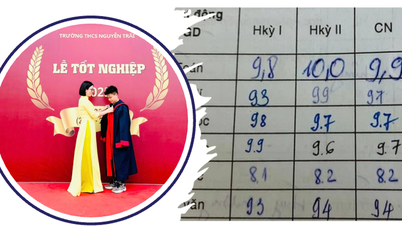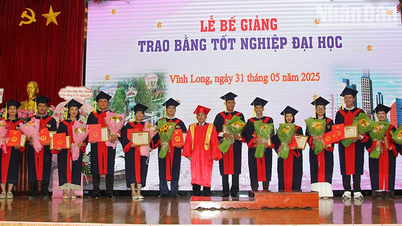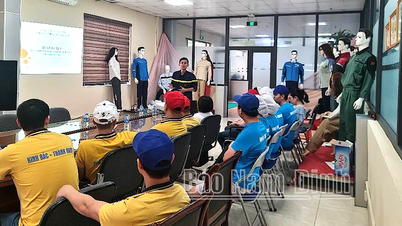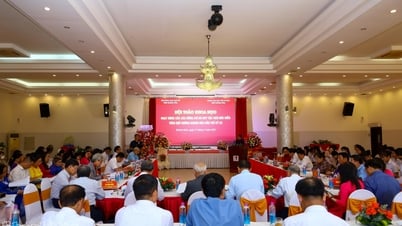
Candidates taking the 2025 Ho Chi Minh City National University Competency Assessment Test - Photo: TRAN HUYNH
Up to now, some universities in the North have announced plans to convert benchmark scores between admission methods. Meanwhile, many universities in the South are confused about this.
Not consistent
The head of the admissions department of a university in Ho Chi Minh City commented: "According to the ministry's instructions, the conversion is based on the same percentile system for different exams, according to the top scores (percentile): 0.5%, 1%, 2%, 5%, 10%... to 50%.
Meanwhile, Hanoi University of Science and Technology builds percentiles for different exams (for example, top 1% - top 0.1% of high school exam scores are equivalent to top 10% - top 3% of thinking assessment test scores).
Meanwhile, Hanoi National University converts according to the Equipercentile based on linked data. This method focuses on preserving the relative ranking of candidates, only publishing the reference conversion table for 2024 but not seeing the specific formula.
Foreign Trade University has published a specific formula, convenient for candidates to calculate themselves. However, this is a simple linear conversion model, does not use percentiles or score distribution analysis, leading to an inaccurate reflection of the difference in difficulty, score distribution between the tests, and does not accurately reflect the distribution of candidates' abilities.
Dr. Nguyen Quoc Chinh - Director of the Center for Testing and Training Quality Assessment of Ho Chi Minh City National University - said that converting all admission methods to the same assessment scale is inherently wrong, so there will not be a correct technical solution for the requirement of determining an equivalent conversion scale.
"The percentile method is only valid when the assessment methods (tests) are similar and evaluate the same value. In reality, the high school exam is quite different from the capacity assessment and thinking assessment tests of the units.
The Ministry of Education and Training's guidelines themselves are contradictory when they admit that it is impossible to convert high school exam scores and academic transcript scores to the same level. Therefore, schools that convert scores differently are saving themselves. If they follow the Ministry's guidelines, how can they recruit qualified candidates?", Mr. Chinh emphasized.
Each method has its own characteristics.
According to Mr. Chinh, the different admission methods have different characteristics. Although they have the same general purpose of admission, they use different metrics to select suitable candidates for different majors and schools.
The flexible application of methods helps schools recruit enough and the right candidates for the majors. Only schools know best what they want because the characteristics (vision, mission, positioning) of each school are different. That is why schools choose different quotas for each admission method.
"The solution to this non-conversion problem is also very vague and pushes the responsibility back to the schools (in contrast to the strict regulations on the conversion scale between high school scores and competency assessment exams).
The Ministry of Education and Training's requirements and instructions on score conversion are unscientific and impractical, causing difficulties for schools and interfering too deeply with their autonomy in enrollment. The most appropriate solution is to remove the regulation on equivalent score conversion," Mr. Chinh suggested.
Admissions officers of many universities in Ho Chi Minh City are also concerned about applying the Ministry of Education and Training's guidelines for score conversion. They believe that using the percentile method according to the Ministry's guidelines requires statistical capacity and big data analysis, which not all schools have enough resources and tools to implement. Therefore, it is easy to lead to errors in the admission process and virtual filtering.
The assessment criteria of exams such as capacity assessment and thinking assessment are completely different from the high school graduation exam. The difficulty of each exam is also different. Therefore, if we take the top 5% of the capacity assessment exam as 5% of the high school graduation exam, it is unscientific and unfair.
"Applying the percentile method and a common conversion framework for the entire school can easily lead to the situation where special, difficult-to-recruit majors will not have candidates admitted under certain methods.
"This can lead to a situation where a candidate's test score is converted to two different scores out of 30 because the conversion framework of the two majors is different, and the standard score does not truly reflect the candidate's nature and ability," said the head of a university's admissions department.
Need to carefully calculate the method of converting points
According to Dr. Sai Cong Hong - former Deputy Director of the Department of Quality Management (Ministry of Education and Training), there are a number of commonly used score conversion methods: linear conversion, percentile, z-score, classification, and statistical simulation. Score conversion needs to be carefully calculated and based on the specific factors of each exam.
Usually, for tests with differences in difficulty or score distribution, people use the percentile method to convert scores (percentile is a way to convert scores using the percentile method - dividing data into 100 equal parts, each part representing 1% of the total data).
"Thus, if we use the percentile method to convert the scores of two different exams taken by the same subject, the prerequisite is that the purpose of the two exams must be the same and the efforts of the candidates must also be the same.
When the statistical data of each test score is not guaranteed to be close to a normal distribution, the selection of percentile scores can lead to bias for this test or that test, or in other words, unfairness in the conversion of scores between these two tests can completely happen" - Mr. Hong analyzed.
Controversial
Mr. Sai Cong Hong also said that converting scores of competency assessment tests is difficult, and without a scientific basis, it can easily cause controversy. For example, the two exams SAT and ACT, although having different structures and scoring scales, have the same purpose of assessing candidates' learning ability and readiness for university admission.
The most important nature of conversion is the same as the assessment purpose. This conversion is not simply a conversion based on the score ratio but is based on the performance of students in actual exams.
The official SAT and ACT conversion tables are based on hundreds of thousands of students who took both tests, over a wide period of time (usually the same year or within a few months).
Source: https://tuoitre.vn/tuyen-sinh-dai-hoc-2025-nhieu-truong-than-kho-quy-doi-diem-xet-tuyen-20250530081513398.htm




![[Photo] General Secretary To Lam receives Chief of the Central Office of the Lao People's Revolutionary Party](https://vphoto.vietnam.vn/thumb/1200x675/vietnam/resource/IMAGE/2025/5/30/140435f4b39d4599a3d17975dfb444c5)























![[Photo] National Conference "100 years of Vietnamese Revolutionary Press accompanying the glorious cause of the Party and the nation"](https://vphoto.vietnam.vn/thumb/1200x675/vietnam/resource/IMAGE/2025/5/30/1cf6cd5c8a934ebfa347028dcb08358c)

































































Comment (0)